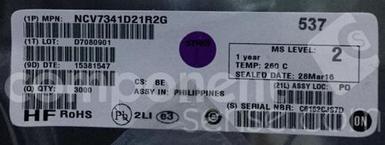The NCV7341 CAN transceiver is the interface between a controller area network (CAN) protocol controller and the physical bus and may be used in both 12 V and 24 V systems. The transceiver provides differential transmit capability to the bus and differential receive capability to the CAN controller. Due to the wide common−mode voltage range of the receiver inputs, the NCV7341 is able to reach outstanding levels of electromagnetic susceptibility (EMS). Similarly, extremely low electromagnetic emission (EME) is achieved by the excellent matching of the output signals. The NCV7341 is a new addition to the ON Semiconductor CAN high−speed transceiver family and offers the following additional features:
●Features
●•Ideal Passive Behavior when Supply Voltage is Removed
●•Separate VIOSupply for Digital Interface Allowing Communication to CAN Controllers and Microcontrollers with Different Supply Levels
●•Fully Compatible with the ISO 11898 Standard
●•High Speed (up to 1 Mb)
●•Very Low Electromagnetic Emission (EME)
●•VSPLITVoltage Source for Stabilizing the Recessive Bus Level if Split Termination is Used (Further Improvement of EME)
●•Differential Receiver with High Common−Mode Range for Electromagnetic Immunity (EMI)
●•Up to 110 Nodes can be Connected in Function of the Bus Topology
●•Transmit Data (TxD) Dominant Time−out Function
●•Bus Pins Protected Against Transients in Automotive Environments
●•Bus Pins and Pin VSPLITShort−Circuit Proof to Battery and Ground
●•Thermally Protected
●•NCV Prefix for Automotive and Other Applications Requiring Site and Control Changes
●•These are Pb−Free Devices
●Typical Applications
●•Automotive
●•Industrial Networks


